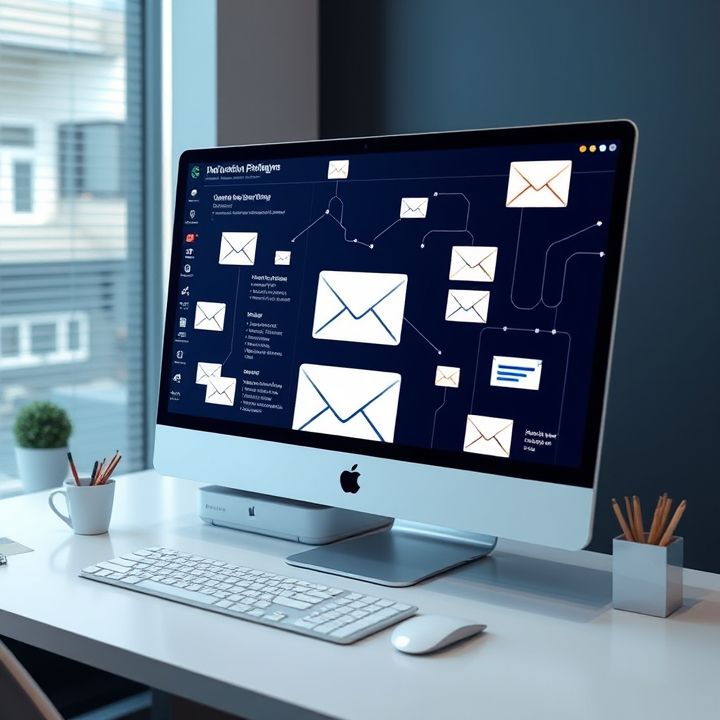Table of Contents
- Introduction
- Understanding the customer journey
- Identifying key touchpoints
- Segmenting your audience
- Crafting personalized email content
- Designing trigger-based email sequences
- Analyzing customer behavior and feedback
- A/B testing email campaigns
- Iterating and optimizing email sequences
- Conclusion
- Frequently Asked Questions
Introduction
Imagine skyrocketing your email marketing results with just one crucial strategy. Yes, that’s right! By incorporating Customer Journey Mapping into your email sequences, you can transform mere subscribers into loyal, engaged customers who can’t wait to hear from you. But what exactly is Customer Journey Mapping, and how can it make such a profound impact on your email marketing? Join us as we unravel the secrets behind this powerful tool and show you how to unlock explosive success.
Understanding your customer’s journey can make the difference between a campaign that converts and one that falls flat. Here’s a quick snapshot:
| Stage | Customer Action | Email Strategy |
|---|---|---|
| Awareness | Discovering your brand | Educational content |
| Consideration | Evaluating your products | Personalized recommendations |
| Decision | Making the purchase | Special offers |
Intrigued? Let’s dive deeper and explore how this method can supercharge your email sequences!
Understanding the customer journey
Understanding the customer journey is crucial for creating effective email sequences. A customer journey map visually represents the steps a customer takes from awareness to purchase and beyond. It helps identify touchpoints where customers interact with your brand, including their needs, concerns, and emotions at each stage.
The customer journey typically consists of several stages: awareness, consideration, decision, and post-purchase. During the awareness stage, customers become aware of a problem or need. In the consideration stage, they research and compare different solutions. The decision stage is where they choose a product or service. Finally, in the post-purchase stage, they experience your product and may provide feedback or seek support.
By mapping these stages, businesses can tailor email content to address specific needs and pain points at each stage. For example, during the awareness stage, emails might focus on educational content that highlights common problems and introduces your brand. In the decision stage, testimonials and case studies can help build trust and encourage purchase. Understanding the customer journey allows marketers to create personalized and relevant email sequences that guide customers smoothly through their buying process.
Identifying key touchpoints
Identifying key touchpoints in the customer journey is crucial for crafting effective email sequences. These touchpoints are the moments when a customer interacts with your brand, and they play a significant role in shaping their overall experience. By mapping out these interactions, you can tailor your email content to address the specific needs and behaviors at each stage of the journey.
Start by analyzing the customer journey from awareness to conversion and beyond. This involves understanding the various stages such as awareness, consideration, decision, and post-purchase. Each stage has distinct touchpoints; for example, the awareness stage may include blog visits or social media interactions, while the decision stage might involve product comparisons or consultations.
Once you have identified these touchpoints, group them into relevant segments. This allows you to create targeted email sequences that address the unique concerns and motivations of each group. Personalized emails that speak to a customer’s specific journey stage can significantly increase engagement and conversion rates. By understanding and leveraging these touchpoints, you can deliver timely and relevant messages that guide the customer seamlessly through their journey.
Segmenting your audience
Segmenting your audience is a critical step in leveraging customer journey mapping to create effective email sequences. By dividing your customer base into distinct groups based on characteristics such as behavior, demographics, and buying patterns, you can tailor your email content to better meet their needs. For instance, first-time buyers may require introductory information and warm welcomes, while returning customers might appreciate loyalty rewards and advanced product updates.
Effective segmentation enables you to deliver highly personalized content, which increases engagement and conversion rates. Use data gathered from various touchpoints in the customer journey, like website interactions and previous purchase history, to inform your segmentation strategy.
Advanced segmentation can also involve dynamic content, where personalized elements within an email change based on recipient information. This not only enhances the user’s experience but also builds a stronger connection between the customer and your brand. By addressing the unique needs and preferences of different segments, you craft email sequences that resonate more deeply and drive meaningful actions, ultimately leading to higher customer satisfaction and loyalty.
Crafting personalized email content
Crafting personalized email content is essential for engaging customers and driving conversions. This process begins by understanding your audience’s preferences, behaviors, and needs, which can be gleaned from customer journey mapping. Personalized emails resonate more with recipients because they feel tailored specifically for them, rather than one-size-fits-all messages.
To accomplish this, segment your email list based on criteria such as past purchases, browsing history, and engagement levels. Use this data to create dynamic content that addresses the unique needs of each segment. For instance, a customer who frequently purchases tech gadgets might appreciate emails about the latest device releases, while a fashion enthusiast might be more interested in seasonal trends and styling tips.
Additionally, personalization goes beyond just addressing customers by their first names. It involves curating email content that aligns with their stage in the customer journey. For example, new subscribers might benefit from welcome series that introduce them to your brand, while loyal customers could receive exclusive offers or early access to new products.
Incorporate customer feedback to continually refine your email content. By leveraging insights from customer journey mapping and maintaining a focus on personalization, your email sequences will become more effective in nurturing leads and fostering long-term customer relationships.
Designing trigger-based email sequences
Designing trigger-based email sequences is a highly effective way to enhance customer engagement and drive conversions. By leveraging customer journey mapping, businesses can pinpoint key actions and behaviors that signal a customer’s movement through different stages of their buying journey. These triggers can include actions such as signing up for a newsletter, abandoning a shopping cart, making a purchase, or engaging with specific content on your website.
Once these key touchpoints have been identified, you can create tailored email sequences that are automatically sent when a specific action is triggered. For example, if a customer abandons their shopping cart, a sequence might be triggered to remind them of the items left behind, offer a discount, or provide additional information to help them complete their purchase. Similarly, welcoming new subscribers with a series of emails that introduce your brand, share valuable content, and guide them towards a purchase can help build strong relationships from the outset.
Trigger-based email sequences allow for a more personalized and timely communication strategy, ensuring that customers receive relevant content at the right moments. This not only enhances their experience but also increases the likelihood of them taking desired actions.
Analyzing customer behavior and feedback
Analyzing customer behavior and feedback is a critical component in creating effective email sequences. By doing so, you gain invaluable insights into what works and what doesn’t in your marketing strategy. First, utilize analytics tools to track customer interactions with your emails, such as open rates, click-through rates, and conversion rates. This data helps identify patterns in customer behavior, allowing you to refine your email content and timing.
Additionally, consider direct feedback from your customers. Surveys, reviews, and customer service interactions provide qualitative data that can help you understand their preferences and pain points. Analyzing this feedback will enable you to tailor your email sequences to better meet your customers’ needs and expectations.
Segmentation is another powerful technique in this process. By grouping customers based on their behavior and feedback, you can create more personalized and targeted email sequences. For instance, new customers might require a welcome series, while loyal customers could benefit from exclusive offers. This targeted approach increases engagement and drives better results.
In summary, a comprehensive analysis of customer behavior and feedback not only enhances your understanding of your audience but also empowers you to create more effective and relevant email sequences.
A/B testing email campaigns
A/B testing email campaigns is a crucial strategy for optimizing email marketing efforts. This method involves sending two variations of an email to a small segment of your audience to determine which version performs better. By comparing metrics such as open rates, click-through rates, and conversion rates, marketers can identify what resonates most with their audience.
To start, create two versions of the email, differing in just one element—this could be the subject line, the call-to-action, or the email layout. This ensures that any difference in performance can be attributed to that particular change. Once you’ve identified the winning version, you can confidently send it to the rest of your email list.
A/B testing helps you understand your audience better, allowing for more personalized and effective communication. It also reduces the risk of poor performance by providing data-driven insights. Over time, continuous A/B testing can significantly improve your email marketing strategy, leading to higher engagement and better results.
Iterating and optimizing email sequences
Iterating and optimizing email sequences is an essential practice to ensure the highest levels of engagement and conversion. After launching your initial email campaign, it is crucial to regularly analyze performance metrics such as open rates, click-through rates, and conversion rates. This data provides insights into which aspects of your emails are working well and which need improvement.
One effective strategy is A/B testing, where you create two versions of an email with slight variations in subject lines, content, or call-to-action buttons. By comparing the performance of these two versions, you can determine which elements resonate more with your audience and make data-driven decisions.
Additionally, segmenting your email list based on customer behavior, demographics, or past interactions allows for more personalized and relevant content. Personalization may significantly increase the effectiveness of your email sequences, as customers are more likely to engage with content that feels tailored to their needs.
Finally, it is essential to stay updated on best practices and industry trends. Regularly reviewing and updating your email sequences keeps your communication fresh and aligned with your audience’s evolving preferences, helping to maintain high engagement levels over time.
Conclusion
In conclusion, customer journey mapping holds the key to maximizing the effectiveness of your email sequences. By understanding and mapping the various stages of the customer journey, businesses can identify key touchpoints and segment their audience effectively. This allows for the crafting of highly personalized and relevant email content that resonates with customers at every stage of their purchasing process. Trigger-based email sequences and A/B testing further enhance the precision and impact of your email campaigns. Additionally, analyzing customer behavior and feedback ensures continuous improvement and optimization, fostering long-term customer relationships and driving higher conversion rates. By integrating customer journey mapping into your email marketing strategy, you can unlock explosive success and supercharge your email sequences, delivering unparalleled value to both your customers and your business.

